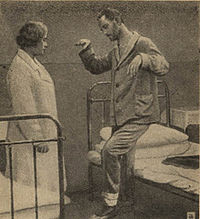
Photo from wikipedia
Introduction Previous studies have shown that in addition to having impairments in facial emotion recognition, patients with schizophrenia also show a lack of facial expression. Although negative symptoms such as… Click to show full abstract
Introduction Previous studies have shown that in addition to having impairments in facial emotion recognition, patients with schizophrenia also show a lack of facial expression. Although negative symptoms such as decreased facial activity are common symptoms of schizophrenia, the related factors remain inconclusive. Therefore, this study compared healthy controls to explore the characteristics of facial muscle activity intensity in patients with schizophrenia and its relationship with negative symptoms. Methods This observational and cross-sectional study conducted in a psychiatric hospital in China included a total of 135 patients with schizophrenia and 134 healthy controls. The negative symptoms of schizophrenia were evaluated using the Brief Negative Symptom Scale. The intensity of facial muscle activity under positive, neutral, and negative emotional stimuli conditions was automatically collected by a computer, including 17 values (F01-F17) that represent different facial muscle activities. Statistical tests were performed to analyze facial muscle activity indexes, to explore an objective and quantitative method to evaluate the negative symptoms of schizophrenia. Results The facial muscle activity intensity of the schizophrenia group at F02 (outer eyebrow), F04 (upper eyelid), F07 (nose), F10 (dimple), F12 (lower jaw 1), F14 (lip 2), and F17 (blink) was lower than that of the healthy controls (p < 0.05). Under positive, neutral, and negative emotional stimuli conditions, the facial muscle activity intensity of F16 (lower jaw 2) was positively correlated with negative symptoms (p < 0.05). Conclusion Our study indicated that patients with schizophrenia show defects in facial muscle activity and that is associated with negative symptoms.
Journal Title: Frontiers in Psychiatry
Year Published: 2022
Link to full text (if available)
Share on Social Media: Sign Up to like & get
recommendations!